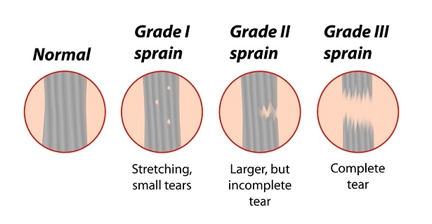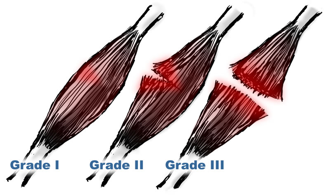Sprain or Strain – What is the Difference?
People often use the words ‘sprain’ and ‘strain’ interchangeably, however, there is a difference in these two injuries. Hopefully, this article will help you understand the difference between a sprain and a strain.

They are both common injuries that can occur in the same region of the body and have similar signs and symptoms. However, the specific types of tissue that are affected are different.
What is a Sprain?
A sprain is a stretch or tear in a ligament. Ligaments are the strong bands of fibrous connective tissue that connects the ends of two bones together. They aid to help stabilize and support the joints throughout our body. Therefore, damage to a ligament can ultimately have an effect on the stability of the joint that it crosses.
The most vulnerable regions of your areas of your body susceptible to a sprain include your ankles, knees, shoulders and wrists.
A sprained ankle can occur when your foot unexpectedly rolls and turns inward, placing extreme tension on the ligaments of your outer part of your ankle. A sprained knee can be the result of a sudden twisting manoeuvre or a collision to the knee by an opposing player or object. A sprained shoulder (AC joint) can occur for example when a hockey player gets body checked into the boards with the point of his/her shoulder, and a wrist sprain can occur when falling on an outstretched hand.
The specific ligaments that experience injuries from sprains include the ACL, PCL, LCL, or MCL around the knee, the ATFL (the most common ligament injured in the ankle), the acromioclavicular joint (shoulder separation), and the ulnar collateral ligament in the thumb.
Ligament Sprains By Severity
 Grade 1 Sprain (mild) – Slight stretching/mild tear of some of the ligament fibers, resulting in little to no joint instability.
Grade 1 Sprain (mild) – Slight stretching/mild tear of some of the ligament fibers, resulting in little to no joint instability.- Grade 2 Sprain (moderate) – Partial tearing of the ligament fibers. There is a resulting abnormal looseness (laxity) you can feel in the joint when it is moved in a certain way.
- Grade 3 Sprain (severe) – A complete tear/rupture of the ligament fibers, causing significant instability/laxity of the affected joint.
What is a Strain?
A definition of a strain is the stretch/tear of muscle or tendon fibers. On the other hand, a tendon is a fibrous cord of tissue that connects each muscle to a bone.
Common areas of strains include your low back, hamstring or calf, including your Achilles tendon. A strain often occurs when the muscle/tendon tissue becomes quickly overloaded. Then, it reaches a breaking point where either a mild, partial or severe tear occurs.
Muscle/Tendon Strains By Severity
 1 – Grade Strain (mild) – stretching or tearing of a small number of fibers.
1 – Grade Strain (mild) – stretching or tearing of a small number of fibers.- 2 – Grade Strain (moderate) – more extensive tearing of the muscle/tendon fibers, but the continuity in the tissue still exists.
- 3 – Grade Strain (severe) – A complete tear/rupture of the muscle or tendon fibers causing a complete loss of continuity.
Teresa Knee, MScPT, Registered Physiotherapist
Trailside Physio – Coquitlam Clinic
No Comments